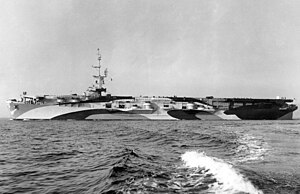This article needs additional citations for verification. (July 2008) |
 USS Commencement Bay
| |
| Class overview | |
|---|---|
| Builders | Seattle-Tacoma Shipbuilding, Washington |
| Operators | |
| Preceded by | Casablanca class |
| Succeeded by | None |
| Built | 1943–1945 |
| In service | 1944–1957 |
| Planned | 35 |
| Completed | 19 |
| Cancelled | 16 |
| Scrapped | 19 |
| General characteristics | |
| Type | Escort carrier |
| Displacement | |
| Length | |
| Beam |
|
| Draft | 30 ft 8 in (9.35 m) |
| Installed power | 16,000 shp (11,931 kW) |
| Propulsion |
|
| Speed | 19 knots (22 mph; 35 km/h) |
| Complement | 1,066 officers and men |
| Armament |
|
| Aircraft carried | 34 |
The Commencement Bay-class escort aircraft carriers were the last class of escort carriers built for the US Navy in World War II.
The ships were based on the hull of the Maritime Commission type T3 tanker, which gave them a displacement of approximately 23,000 tons and a length of 557 feet (170 m). Unlike most earlier escort carrier classes, which were laid down as something else and converted to aircraft carriers mid-construction, the Commencement Bays were built as carriers from the keel up. Their general layout was similar to the Sangamon-class escort carriers, but some of the Sangamon's engineering shortcomings were addressed.
They entered service late in World War II – USS Commencement Bay launched on 9 May 1944 – so most of them saw little or no operational service. Thirty-five of them were ordered but many were cancelled prior to completion. Nineteen saw commissioned service in the US Navy, four were broken up on the ways at the end of the war, two were accepted from the builders but never commissioned, and the remainder were cancelled before being laid down.
After the war they were seen as potential helicopter, anti-submarine, or auxiliary (transport) carriers, and a number of ships served in these roles during the Korean War. The oncoming Jet Age ended their careers, as the ships were no longer large enough to safely carry the much larger jet aircraft of the late 1950s, and all units were out of service or reclassified by 1960.